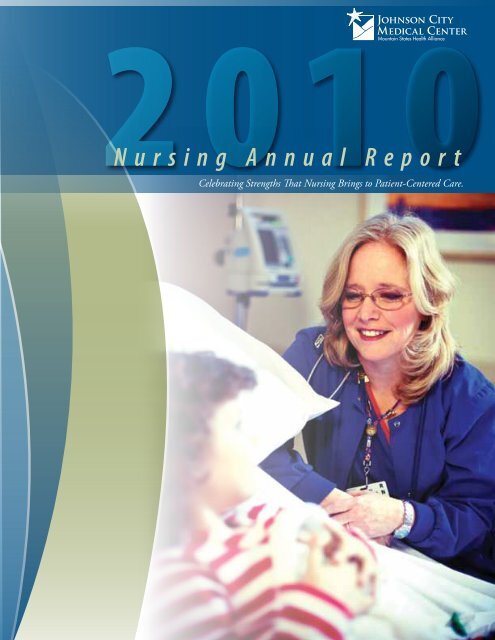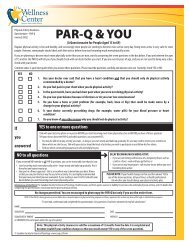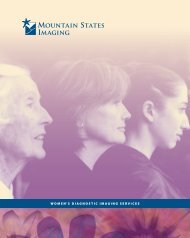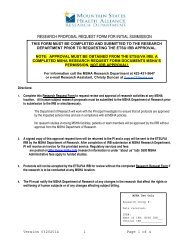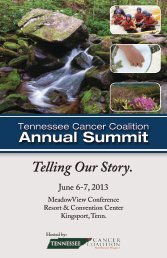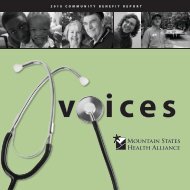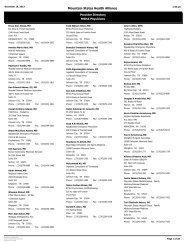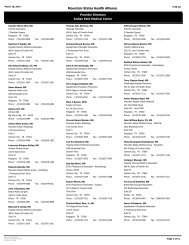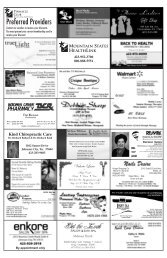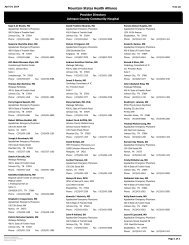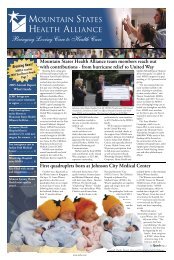Nursing Annual Report - Mountain States Health Alliance
Nursing Annual Report - Mountain States Health Alliance
Nursing Annual Report - Mountain States Health Alliance
Create successful ePaper yourself
Turn your PDF publications into a flip-book with our unique Google optimized e-Paper software.
2010N u r s i n g A n n u a l R e p o r tCelebrating Strengths That <strong>Nursing</strong> Brings to Patient-Centered Care.
2From the Chief <strong>Nursing</strong> OfficerIt is with great pleasure and pride, as the Chief <strong>Nursing</strong> Officerof JCMC, that I introduce this year’s <strong>Nursing</strong> <strong>Annual</strong> <strong>Report</strong>. Ithas been an exciting year for health care and for nursing with theintroduction of the Institute of Medicine <strong>Report</strong> on <strong>Nursing</strong> inOctober. At JCMC, we have realized significant improvement inall of our core measures, with nurses leading many of the initiativesthat have contributed to that success. I have the pleasure of readingpositive comments made by our patients and seeing our PressGaney scores improve, especially our nursing scores. The NDNQIRN Satisfaction and Morehead scores reflect improvement in ourRN to RN Interaction, <strong>Nursing</strong> Management and Autonomymeasurements over this past year.I am especially proud of the support and commitment of all duringthe transition of our new community hospital, Franklin WoodsCommunity Hospital. In the true spirit of a Magnet hospital, ournursing staff gave 200% to ensure the safety and well-being of ourentire patient population during this transition.I want to take this time to congratulate all of you on your manyaccomplishments, the greatest being this year’s recognition at the<strong>Annual</strong> Magnet Conference for our Magnet Redesignation.With sincere appreciation for your many accomplishments to the“BEST” nursing team,Our Mission<strong>Mountain</strong> <strong>States</strong> <strong>Health</strong> <strong>Alliance</strong> is committed to BringingLoving Care to <strong>Health</strong> Care. We exist to identify and respondto the health care needs of individuals and communities in ourregion and to assist them in attaining their highest possible levelof health.Our VisionWe passionately pursue healing of the mind, body and spirit aswe create a world-class health care system.Our ValuesIntegrity… honesty in everything we doService… with caring and compassionLeadership… with creativity and innovationExcellence… always pursuing a higher standardPat Niday, VP,CNO
ContentsA Message from the CEO —————————————————— 4New Magnet Model ———————————————————— 5Magnet Redesignation ——————————————————— 6Transformational Leadership ————————————————— 8Structural Empowerment —————————————————— 11<strong>Nursing</strong> Grand Rounds——————————————————— 12Recognition of Nurse ———————————————————— 13Exemplary Professional Practice ———————————————— 14Shared Governance Structure ————————————————— 17New Knowledge, Innovation and Improvement —————————— 18The Maternal-Child Leadership Academy ———————————— 19Frontline Leadership Academy ———————————————— 20Empirical Quality Outcomes————————————————— 21Quality Awards—————————————————————— 22Satisfaction Scores ————————————————————— 24Breast Cancer Event ———————————————————— 25Strategic Plan——————————————————————— 26<strong>Annual</strong> StatsAdmissions ——————————— 26,808Admissions–Rehab —————————— 673Average Length of Stay–Acute ——— 5.10Average Length of Stay–Rehab ———— 13.61Average Length of Stay–Newborns —— 1.70ED Visits ——————————— 49,028Surgery Cases–IP ————————— 7,808Surgery Cases–OP ————————— 6,737Transplants ————————————— 47Wings Flights——————————— 1,2753Bringing Loving Care to <strong>Health</strong> Care | www.msha.com
4A Message from the CEOIn 2009 Johnson CityMedical Center achievedredesignation as a MagnetHospital, Tennessee’s firsthospital to achieve thisprestigious honor. Theyear 2010 has been equallysuccessful and progressivefor our nursing team. Thecommitment to Patient-Centered Care by ourteam members has shownsignificant improvement inquality throughout the year.As CEO of Johnson CityMedical Center, I am proud to work with such a high caliber ofnursing professionals.Johnson City Medical Center had a focus this year on providingthe right care to the right patient in the right location at the righttime, always. As the tertiary referral hospital for a 29-county regionspanning four states, our nurses achieved a rate of greater than 98%for acceptance and placement of patient transfers from externalfacilities. The coordination of patient flow, discharge planning andcommunication among hospital departments showed the excellentteamwork across the facility among our caregivers.This was also a year of significant quality improvement withdecreases in the rate of central line-associated blood streaminfections (CLABSI) and catheter-associated urinary tractinfections (CAUTI). Our clinical teams not only focused onunit-based improvements but also developed processes to havecontinuous and consistent improvements in every clinicaldepartment throughout the hospital.Significant accomplishments have been recognized at Johnson CityMedical Center this year, including achievement of the top quartilewith RN to RN interaction and RN management satisfaction onthe National Database of <strong>Nursing</strong> Quality Indicators (NDNQI)survey. At James H. & Cecile C. Quillen Rehabilitation Hospital,excellent patient care was recognized by the Commission onAccreditation of Rehabilitation Facilities (CARF) with fullaccreditation.I am very proud of the clinical teams at Johnson City MedicalCenter and am looking forward to the continued successes andprogress of our nurses in the future.Bradley K. Nurkin, Senior VP,CEO
New Magnet Model5Global Issues in <strong>Nursing</strong> and <strong>Health</strong> CareStructuralEmpowermentTransformationalLeadershipEmpiricalOutcomesNew Knowledge,Innovations &ImprovementsExemplaryProfessionalPracticeTransformational Leadership:The CNO in a Magnet organization is a knowledgeabletransformational leader who develops a strong vision and wellarticulatedphilosophy, professional practice model and strategicand quality plans in leading nursing services.Structural Empowerment:Magnet structural environments are generally flat, flexible anddecentralized. Nurses throughout the organization are involved inself-governance and decision-making structure and processes thatestablish practice and address issues of concern.Exemplary Professional Practice:A professional practice model is the overreaching conceptualframework for nurses, nursing care and interdisciplinary patientcare. It depicts how nurses practice, collaborate, communicate anddevelop professionally to provide the highest quality of care forthose served by the organization.New Knowledge, Innovations andImprovements:Magnet organizations integrate evidence-based practice andresearch into clinical and operational processes. Nurses are educatedabout evidence-based practice and research, which enables them toexplore the safest and best practices and to generate new knowledge.Empirical Outcomes:<strong>Nursing</strong> makes an essential contribution to patient, nursingworkforce and community outcomes. The measurement of qualityoutcomes is imperative and directly related to nursing leadershipand clinical practice in Magnet organizations.American Nurses Credentialing Center. (2008). Application Manual Magnet Recognition Program. Silver Springs, MD: Author.Bringing Loving Care to <strong>Health</strong> Care | www.msha.com
6MagnetRedesignationRetreatIn May 2010, nurses from JCMC and QRH celebrated our MagnetRedesignation during Nurses’ Week. Guest speaker Dr. Trisha Thomas,Ph.D., MSN, RN, provided motivating presentations on nursingleadership, professional development and nursing empowerment. Dr.Thomas was one of our Magnet surveyors in September 2009 as partof the Magnet Redesignation survey team. While in Johnson City, Dr.Thomas attended several of our Nurses’ Week celebrations. During ourMagnet Retreat day, Stacey Jones, director of <strong>Nursing</strong> Practice andQuality, presented on nursing’s exemplary performance and opportunitiesfor growth identified from the 2009 Magnet survey. Stacey also reviewedthe change in format from the 14 forces of Magnet to the five Magnetdomains as exemplified through this annual report. The five domainsfor the document in 2013 are Transformational Leadership; StructuralEmpowerment; Exemplary Professional Practice; New Knowledge,Innovation and Improvement; and Empirical Outcomes.Pat Niday, VP and CNO, presented on Magnet and the excellence in<strong>Nursing</strong> at JCMC and QRH. As part of her presentation, Pat alignedthe similarities of Magnet with the Baldrige Criteria for PerformanceExcellence. During the afternoon sessions, attendees broke out into smallgroups to closely examine the new domains of Magnet. Each group thenparticipated in an exercise to match each source of evidence of Magnetwith that of Baldrige’s Criteria of Performance Excellence. All of thispreliminary work provided us with the framework for our MSHA <strong>Nursing</strong>Strategic Plan of 2009-2013.
8Transformational Leadership(Forces of Magnetism: Quality of <strong>Nursing</strong> Leadership, Management Style)Global Issues in <strong>Nursing</strong> and <strong>Health</strong> CareStructuralEmpowermentTransformationalLeadershipEmpiricalOutcomesNew Knowledge,Innovations &ImprovementsExemplaryProfessionalPracticeTransformational leadership describesnurses who are knowledgeable, strongrisk-takers who follow a well-articulated,strategic philosophy in the day-to-dayoperations of nursing services. Nurses,at all levels of the organization, conveya strong sense of advocacy, vision andsupport for the nursing staff and forthe patient.Pat Niday, VP and CNO, conveys a strongand supportive role as our chief nursingofficer at Johnson City Medical Center.Under the CNO’s scope of practice, Pathas direct-line authority responsibilitiesand matrix responsibilities where nursingis practiced at JCMC. Pat is the leaderwith the development of our MSHA<strong>Nursing</strong> Strategic Plan that outlinesstrategies for optimizing outcomes throughimproved clinical processes, enhancingfinancial performance and creating a safeenvironment for patients and caregivers.Promoting patient safety, quality nursingcare, and patient and nursing satisfactionare major components in ensuring Patient-Centered Care, positive patient outcomesand integrity in everything we do.Results from the 2009 NDNQI RNSatisfaction Survey demonstrate anincrease in <strong>Nursing</strong> Management T-Scoresover this past year. Our nursing leaders,Pat Niday and Candace Jennings, RN,senior vice president/CEO of WashingtonCounty Operations, serve as strong andvisible leaders for the front-line teammembers of JCMC. Pat and Candaceattend the newly restructured <strong>Nursing</strong>Retention Committee, which is co-chairedby front-line nurses and the manager ofHuman Resources.
9Cathy Ivory Lisa Smithgall Misty SpanoCathy Ivory, RNC-OB, MSN,Ph.D. (c) was elected to theNational Board of Directorsof the Association of Women’s<strong>Health</strong>, OB and NeonatalNurses (AWHONN); her twoyearterm began Jan. 1, 2011.AWHONN represents morethan 22,000 nurses includingRNs, nurse practitioners,certified nurse-midwives, andnurse-executives with an overallmission to promote the healthof women and newborns. Herresponsibilities include assuringeffective leadership and soundmanagement, establishing strategicdirection, overseeing businessrequired to carry out the missionand the goals of the association.Other duties include setting thecore program, fiscal functions, andappointing panels and committees.On Dec. 18, 2010, Lisa Smithgall,RN, MSN, vice president ofWomen’s Services at MSHA,received her doctor of philosophyin nursing from East TennesseeState University. Lisa became anurse 27 years ago and has heldmany nursing leadership positionswhile working on her master’s anddoctorate degrees in nursing. Dr.Smithgall’s dissertation researchis titled, “Perceptions of MaternalStress and Neonatal PatientOutcomes in a Single Private RoomVersus Open-Room NeonatalIntensive Care Unit Environment.”Her research was conductedto describe the perceptions ofmaternal stress related to thehospitalization of a neonate in thetwo different NICU environments.In addition, the research describedthe neonatal outcomes of ventilatordays, average length of stay, averageweight gain, incidence and gradeof intraventricular hemorrhage,and the incidence of parent visitsin both the open-room and singleprivate room neonatal intensivecare unit environments. Thisdissertation research will be one ofvery few published reports on theoutcomes of preterm infants andmaternal stress described in thesingle private room and open-roomNICU environments.Misty Spano received the Servant’sHeart Award for Leadershipin 2010. Misty is the programcoordinator for the Joint, Spineand Fractured Hip programs atJCMC. Misty has been employedby MSHA since 1996 and hasbeen recognized for her constantefforts in “bringing loving careto health care” to the patientsat JCMC. Misty has beeninstrumental in the developmentof the newly created FracturedHip program, which startedin 2010. Misty demonstratesexemplary professional practiceand innovation as a nursing leader,defining what nursing excellence isall about.Bringing Loving Care to <strong>Health</strong> Care | www.msha.com
Structural Empowerment(Forces of Magnetism: Organizational Structure, Personnel Policies and Programs, Community and the <strong>Health</strong> CareOrganization, Image of <strong>Nursing</strong>, Professional Development)11StructuralEmpowermentGlobal Issues in <strong>Nursing</strong> and <strong>Health</strong> CareTransformationalLeadershipEmpiricalOutcomesNew Knowledge,Innovations &ImprovementsExemplaryProfessionalPracticeNurses throughout JCMC are involvedin decision-making councils, committeesand task forces that provide the structureto collaborative practice. Front-linenurses and other care providers createpartnerships to enhance patient caredelivery in a safe and efficient manner.<strong>Nursing</strong> leaders throughout JCMC alsoserve on committees that address patientcare, operational management, nursingcare and patient satisfaction.Nurses extend their influence insupporting new team members’professional growth and development intothe nursing community. An example ofsuch growth and development began inJune 2009. The Emergency Department’sOrientation Curriculum, based on PatriciaBenner’s model “From Novice to Expert:Excellence and Power in Clinical <strong>Nursing</strong>Practice,” started with a cohort of 32nursing graduates. This pilot programwas started due to feedback receivedfrom nursing graduates that describedthe previous Emergency Department’sorientation as too rigid, lacking adequateresources and unorganized.The quantitative outcomes for thisprogram were realized in December 2010.Thirty-two nurses entered the programin June 2009. As of January 2011, 30nurses were retained for a 97% retentionrate. One nurse transferred internallyafter one year in the ED. Sixteen nursepreceptors were trained on the AdultLearning Theory, Benner’s Model, andED Orientation Pathway. Eight mentorswere trained in the Social LearningTheory, Benner’s Model and Applicationfor Mentors, and the ED OrientationModel. The overall RN turnover rate forFY’09 was 11.2% and for FY’10 was 9.2%.Patient Satisfaction increased from 80.7 inJune 2009 to 88.8 in January 2011.Bringing Loving Care to <strong>Health</strong> Care | www.msha.comNurses also commented on the programstating that they felt “at ease” inindependent practice as compared to peerson other units one month after releasefrom orientation. They “strongly agreed”that time flexibility of the orientationpathway benefitted their ability to care forpatients in a superior manner compared topeers on other units.
12<strong>Nursing</strong> Grand RoundsA mock deposition was developed in collaboration with thehospital legal department and included the use of an actual patientchart, the deposition of two nurses who had cared for the patient,and conducted in a room set up to simulate the appropriateenvironment. The team members were sworn in and had attorneyspresent to complete the simulation. The purpose of this sessionwas to heighten awareness of the need for accurate and appropriatedocumentation. One simulated deposition involved outcomesrelated to a patient safety incident and inadequate documentation,while the other illustrated adequate documentation.The Least Suspicious Patient involved teaching about severe sepsisusing an actual patient’s case. This educational activity provided anopportunity to increase awareness of the need for early screeningand recognition, and early goal-directed therapy. This sessionincluded real de-identified patient data that demonstrated how toappropriately screen patients for sepsis early to avoid poor patientoutcomes. Participants were able to use the sepsis screen at multiplepoints in the case to learn how to quickly identify those patientssuffering from sepsis or at risk for sepsis. This session was repeatedat other facilities in the alliance as well as at the 17th annualPulmonary Symposium and was well-attended.
Nurse Recognition5 Star Awards13Jennifer Gilliam, RNJanie Walker, RNJustin Fletcher, RNAmy Baker, RNJessica Bartley, RNCarla Brown, RNJaime Barboza, RNCarolyn Lawson, RNJudy Williams, RNCynthia Hensley, RNKim Bacon, RNHylan Jenkins, PCPFrank Hopper, PCPCindy Bass, RNMary Sue Brooks, RNThe Cardiopulmonary Rehab TeamSuper Star Team:Michelle PhillipsCarolyn LawsonEverett BakerPam BaysJared CakebreadRobin LynchDebbie FogleTim BeanCarrie ArrowoodBelinda TurnerBringing Loving Care to <strong>Health</strong> Care | www.msha.com
14Exemplary Professional Practice(Forces of Magnetism: Professional Models of Care, Consultation and Resources, Autonomy, Nurses as Teachers,Interdisciplinary Relations, Quality of Care: Ethics, Patient Safety and Quality Infrastructure, Quality Improvement)TransformationalLeadershipGlobal Issues in <strong>Nursing</strong> and <strong>Health</strong> CareStructuralEmpowermentEmpiricalOutcomesNew Knowledge,Innovations &ImprovementsExemplaryProfessionalPracticeA professional practice model is theoverarching framework for nurses,nursing care and interdisciplinary care.The schematic description exemplifieshow nurses practice, collaborate,communicate and develop professionallyto provide excellence in nursing care.Our professional practice modelillustrates the alignment of nursingpractice with the organization’s mission,vision, values and Patient- Centered Carephilosophy.Interdisciplinary collaboration mustbe evident in the care delivery systemdemonstrating the importance ofpartnerships with patients and familieswith physicians, pharmacy, nutrition,therapy, advanced practice nursesand case management. Exemplaryprofessional practice is grounded by aculture of safety, quality improvementand evidence-based practice. Nursescollaborate with other disciplines toensure safe and effective care.
Exemplary Professional Practice (cont.)Poster abstracts and podium presentations at national nursingconferences are rewarding both to the nurse and to the conferenceattendees. Some national conferences receive up to 1,600 poster orpodium submissions from nurses all over the world. Networkingwith nurses from various parts of the country and even globallycreates a sense of support and collaboration in improving patientcare. The following list includes our nurses who have presented atnational conferences:Myra Hale, RNC-OB, and Liane Jennings, RNC-OBFamily Birthing CenterPodium: “Just in Time: Improving Scheduled Cesarean Start Time”Association of Women’s <strong>Health</strong>, Obstetric and Neonatal <strong>Nursing</strong>(AWHONN)Las VegasPatti Jacobs, RNObstetric Outreach EducatorPoster: “Use of Simulation for Education of Rural <strong>Health</strong> CareProviders”AWHONNLas VegasPat Niday, RN, Ed.D.Vice President and Chief <strong>Nursing</strong> Officer of JCMCPoster: “Magnet & Baldrige: The Quality Crosswalk forHardwiring Excellence”Podium: “Preventing Hospital Gridlock”Tennessee Hospital Association (THA)Nashville, Tenn.15Cindy Bass, RN, LCCE, and Barb Leduc, RNPerinatal EducationPoster: “Prenatal Education Website Development and Design”AWHONNLas VegasLisa Carter, MSN, RNNurse Manager of Pediatrics/PICUPoster: “Seeing is Believing”AWHONNLas VegasGeorgita Washington, Ph.D., RN-BC, MSNClinical Specialist for Acute MedicinePodium: “Effects of Anxiety-Reducing Interventions onPerformance in Graduate Nurses”Podium: “Research Ahoy!”Sixth <strong>Annual</strong> Southeastern <strong>Nursing</strong> Staff Education SymposiumPinehurst Resort, North CarolinaRebecca Pullon, RN, Nurse ManagerChest Pain CenterPoster: “Chest Pain Center-Emergency Department Nurse Liaison”<strong>Annual</strong> Magnet ConferencePhoenixLisa Smithgall, Ph.D., RNC, NEA-BCVice President of Women’s Strategic Service UnitPodium: “Assessment for Hypoglycemia in Newborns DuringTransition: A Retrospective Study”AWHONNLas VegasBringing Loving Care to <strong>Health</strong> Care | www.msha.com
16Katie Rice Stacie Davis Lisa BoghozianKatie Rice, a graduate of ETSU,has been a nurse for six years andis a certified inpatient obstetricsnurse. She is MSHA’s systemadministrator for the CentricityPerinatal (CPN) system, used formaternal/fetal monitoring andnursing documentation in theOB units and newborn nurseriesof four MSHA facilities. Plansfor the coming year include fulldeployment of CPN at the tworemaining MSHA facilities withOB units. Katie won two qualityawards and the 2008 Women’sand Children’s Services <strong>Nursing</strong>Excellence Award for her work withCPN. She is an active member ofthe nationwide CPN user group.She spoke at the 2010 nationalCPN conference, and was presentedwith GE <strong>Health</strong>care’s “OutstandingCentricity Perinatal Focus GroupParticipant” Award, recognizingher contribution to focus groupswith the purpose of improving anddeveloping various aspects of CPN.Katie is pursuing her master’s in<strong>Nursing</strong> Informatics.Stacie Davis, nurse manager forthe Inpatient Oncology unit, wasselected out of several applicantsto assist the Oncology <strong>Nursing</strong>Certification Corp. (ONCC)in writing questions for theirnext national exam. The ONCCis directly affiliated with theOncology <strong>Nursing</strong> Society (ONS)and is a nonprofit organization thatdevelops, administers and evaluatesprograms for certification. Theorganization elects 24 people acrossthe country to assist in writingquestions that will appear on thenext certification exam for oncologynurses. Stacie’s extensive experienceand certification as a chemotherapytrainer has provided her with thiswonderful opportunity. As Staciestates, “It has been a goal of mineto help shape the future of nursingas far as oncology knowledge.There are always students aroundand therefore a lot of teachingopportunities to pass along what Ihave learned.”Lisa Boghozian won theAmerican Association of CriticalCare Nurses (AACN) Circle ofExcellence national award for herwork in the Adult Intensive CareUnits. Lisa was very instrumentalin leading many of the initiativesthat resulted in positive patientoutcomes. Lisa’s diligence andpersistence in her implementationof the Plan-Do-Check-Actimprovement methodology and“small tests of change” allowed herto follow the workflow and refinethe process. Her philosophy isto bring education to the frontlinenurse and to stimulate themto think beyond the task andaccept responsibility for changingpractice and achieving excellence.
Shared Governance Structure17Practice Council· Named front-line RN as co-chair – Teresa Smith, RN· Structured agenda items under Magnet domains· Increased front-line membership· Increased emphasis on nursing practice excellence and patient safety· <strong>Nursing</strong>/Pharmacy council formed from this council· Interdisciplinary approach to care of the patientQuality Council· Named front-line RN as co-chair – Kathy Banks, RN· Structured agenda items under Magnet domains· Increased front-line membership· Increased emphasis and reporting of core measure data· <strong>Nursing</strong>/Lab council formed from this council· Front-line team member reports monthly on Performance Improvement project in their unitProfessional Development Council – Georgita Washington Ph.D., RN-BC, MSN· Developed JCMC extended orientation to new team members· Interactive learning with hands-on demonstrations· Instrumental in presenting two <strong>Nursing</strong> Grand Round sessions - The Least Suspicious Patient and Mock Trial· Facilitated IV skill sessions for new and experienced nurses· Focused on Evidence-Based Practice as core for education developmentEvidence-Based Council (formerly known as the MSHA Research Council)· Presented 5th <strong>Annual</strong> Research Conference on the V.A. campus showcasing multidisciplinary research· Mentored novice nursing researchers· Instrumental in the CHOMP (Comprehensive Hospital Oral Management Program) study at JCMC· Instrumental in the IV Phlebitis study at JCMCBringing Loving Care to <strong>Health</strong> Care | www.msha.com
18New Knowledge, Innovationand Improvement(Forces of Magnetism: Quality of Care: Research and Evidence-Based Practice, Quality Improvement)Global Issues in <strong>Nursing</strong> and <strong>Health</strong> CareStructuralEmpowermentTransformationalLeadershipEmpiricalOutcomesExemplaryProfessionalPracticeNew Knowledge,Innovations &ImprovementsThe domain of New Knowledge,Innovations and Improvements integratesevidence-based practice, nursing research,and quality of care initiatives into clinicaland operational processes. Nurses areeducated on evidence-based practiceand explore the safest and best practicesthat provide the best care to our patients.Innovations in patient care and nursingpractice generate new and thoughtprovokingideas and processes to establishhigh-quality, effective and efficient patientcare.
The Maternal-Child Leadership Academy19The challenge of increasing breast-feeding rates in this area ofTennessee is being researched by two nurses at JCMC in an effortto raise the awareness of the positive effects of breast-feeding on achild’s long-term health. The two nurses are Cathy Ivory, RNC-OB,MSN, Ph.D.(c), corporate director of Women’s Services for MSHA,and Ann Perry, RN, IBCLC, clinical coordinator for LactationServices for MSHA. Ivory and Perry were selected to participate inan elite and highly competitive leadership development project.The 18-month project is part of the Maternal-Child <strong>Health</strong>Leadership Academy offered by the Honor Society of <strong>Nursing</strong>,Sigma Theta Tau International and Johnson & Johnson. Perry states“I’m honored to have been invited to participate in the Maternal-Child <strong>Health</strong> Leadership Academy. I am very passionate about theeducation and support we provide to our breast-feeding families andlook forward to this leadership challenge with great expectations.”The Maternal-Child Leadership Academy develops the leadershipskills of maternal-child health nurses and prepares nurses foreffective interprofessional team leadership as they strive to improvethe quality of care for childbearing women and children up to5 years old. Johnson & Johnson places a high value on nursingleadership and social responsibility. They have a strong strategicfocus on building partnerships with programs that enhance andinfluence nursing practice. The specific project goals for Ivory andPerry are working on strategies to keep mothers and new babiestogether as much as possible after birth and before they go home,and increasing the ability of all MSHA nurses who work withmothers and babies to assist and promote breast-feeding.Bringing Loving Care to <strong>Health</strong> Care | www.msha.com
20Frontline Leadership Academy<strong>Nursing</strong> leadership priorities in today’s health care system areever-changing, and the nursing profession requires strong,innovative leaders who can transcend challenges and transformthe nursing profession for future success. Transformationalleadership skills lead to positive team relationships, increasedeffectiveness and increased nursing satisfaction. The AdvisoryBoard Company-Center for Frontline <strong>Nursing</strong> Leadership hasprovided personal and professional educational opportunities indeveloping nurses in leadership roles. Front-line nurses who werechosen from JCMC and QRH gained valuable knowledge andexperience in leadership management skills, team-building skills,and overall understanding of leadership roles. Nurses who havetaken part in these sessions are as follows:ParticipantsAmy Baker, RNTiffany Barnette, RNDustin Campbell, RNTiffany Hodge, RNRobin Lyons, RNCheryl McKesson, RNRebecca Pullon, RNTara Royston, RNPatty Surber, RNClara Beth Payne, RNPhilip Haun, RN
21Empirical Quality Outcomes(Forces of Magnetism: Quality of Care)Global Issues in <strong>Nursing</strong> and <strong>Health</strong> CareStructuralEmpowermentTransformationalLeadershipEmpiricalOutcomesNew Knowledge,Innovations &ImprovementsExemplaryProfessionalPracticeThe measurement of quality outcomes isimperative to display the organization’spractice performance. Using graphsand charts are two methods to illustrateoutcomes such as core measures, patientsatisfaction scores and Blueprint goals.The relationship between the structureand the process yields the associatedoutcomes. These outcomes must bemonitored continually in order to defineareas of improved performance and thoserequiring additional work.The annual NDNQI RN SatisfactionSurvey is an example of measurementdata that nursing leadership use tocreate or revise structures or processespertaining to the job satisfaction of RNs.Bringing Loving Care to <strong>Health</strong> Care | www.msha.com
22Quality Awards 2010With national organizations and regulatory agencies increasingthe accountability to reduce restraint usage in behavioral healthsettings nationwide, Woodridge Psychiatric Hospital took on thischallenge by utilizing innovative methods. While their restraintusage was below the national average, Woodridge felt that therewere opportunities for improvement within their processes thatwould lead to further reductions. After months of meeting toassess their needs, they implemented a “Behavioral <strong>Health</strong> RapidResponse” team and developed a new role - behavioral healthsafety facilitator.The behavioral health safety facilitator provided consistent teammember education on the use of HELP (Human Empowermentand Leadership Principles), which included education onthe enhanced effectiveness of verbal de-escalation and theimplementation of physical interventions designed to preventinjuries to patients and staff. The development and implementationof a Behavioral <strong>Health</strong> Rapid Response Team (BHRRT) providedearly identification and interventions for those patients who displayearly symptoms of agitation. Members of the BHRRT representdiffering disciplines and were educated on the process of RapidResponse and on de-escalation techniques.Starting in 2009, team members directly involved in the BHRRTwere involved in feedback loops. Feedback provided through thismechanism led to a revision of processes and a more consistentmanner of data collection in order to serve the patient and thecaregivers in a better, more enhanced manner. In 2010, year-to-datetotal for patients who required restraints was 1.15 per 1,000 patientdays as compared to 2006’s rate of 3.24, a 64.5% reduction in thenumber of patients requiring restraints for 2010.Since 2007 Woodridge has experienced a significant reduction inboth the number of patients requiring restraint and the number ofrestraint episodes. The progress of these efforts is communicatedto all team members at Woodridge on a monthly basis. Thiscommunication provides ongoing testimony to team collaboration,exemplary professional practice and ongoing process improvement.
NICU Interdisciplinary Team23CLABSI: Our Journey to ZEROQuality Award Winner - Level 4/ Stakeholder Safety AwardAn infection in a neonate is the most common cause of mortalityin very low birth weight infants. A central line-associated bloodstream infection in a neonate can increase the hospital length ofstay between 14 and 24 days. The National <strong>Health</strong>care SafetyNetwork reported in 2008 the average CLABSI rate was 2.4/1,000line (device) days. In Tennessee, the average rate was 3.04/1,000line days. At JCMC our Neonatal Intensive Care Unit’s rate was5.23/1,000 line days. In May 2009, NICU joined forces with theTennessee Initiatives for Perinatal Quality Care (TIPQC) andformed a CLABSI task force by identifying their stakeholders andgaining leadership support. Their goal was to decrease CLABSIsby 50%. By examining current practice, policies, evidenced BestPractice Guidelines, and reviewing current literature they createdan action plan.They educated NICU front-line staff using the “train the trainer”method, altered dressing and tubing procedures, added silverimpregnated discs to insertion sites, and began daily central linerounds. Another part of their action plan was to incorporateancillary staff in their education. They posted a “stop” sign to alertthose team members that the infant had a central line. This was tocreate an environment of safety for all team members to support theinitiatives they had put in place to decrease their CLABSI rates.Bringing Loving Care to <strong>Health</strong> Care | www.msha.comWith these efforts put into place, their CLABSI rates greatlydiminished. In FY’08, they had 20 CLABSIs with a year-to-daterate of 5.23/1,000 line days. In FY’09, they had seven CLABSIswith a rate of 1.49/1,000 line days and in FY’11, two CLABSIs witha year-to-date rate of 1.15/1,000 line days.Team efforts such as these demonstrate that all team membersmake a difference at the bedside. Decreasing CLABSI ratesdecreases mortality rates and length of stay, thus decreasing hospitalcosts. We congratulate this team for all of their efforts and the carethat they provide to their patients.
24Satisfaction Scores<strong>Mountain</strong> <strong>States</strong> <strong>Health</strong> <strong>Alliance</strong> uses multiple approachesto listen to our patients by obtaining actionable informationfrom their feedback. The Press Ganey Satisfaction surveyis one method of obtaining this information. MSHA usesPress Ganey as its primary method for measuring patientsatisfaction. Nurses throughout MSHA have a substantialimpact on patient satisfaction. By using the Press Ganey scoreson nurse-sensitive indicators we can obtain useful and valuableinformation about our nursing care and attention to patientneeds. The Magnet Recognition Program through the ANCCsee nurses as impacting patient satisfaction through nursedriveninterventions such as pain management, promptness tocalls, attention to special needs or requests, and keeping patientsinformed of their care. These nurse-sensitive indicators willbe reported to the Magnet Recognition Program biannually.The Patient Satisfaction Score graph displays four years of datarevealing our nursing scores. Friendliness/Courtesy of Nurses isthe highest ranking score followed by attention to special needsand requests. Promptness to calls and pain management wereslightly lower but are showing yearly improvement.An approach to gain valuable and beneficial feedback from ourregistered nurses is through the NDNQI RN Satisfaction annualsurvey. Approximately 1,500 hospitals nationwide participate inthis yearly survey. This tool assists efforts to address the needsof the nursing staff, such as work environment opportunities,performance improvement, and recruitment and retentionefforts. Our survey results revealed our RN-to-RN Interactionis in the highest satisfaction quartile, which demonstrates theexceptional collaborative working relationship of nurses. Next,the professional status indicator has increased over the past twoyears with a slight slope downward, but remains in the moderatesatisfaction quartile. The autonomy nursing indicator has alsoshown yearly improvement since 2007 and continues to be inthe moderate satisfaction quartile. By analyzing the data fromthe survey, nursing leaders can begin the process of addressingopportunities for improvement and implement methods thatinfluence front-line nurses’ satisfaction.
Breast Cancer EventBreast Cancer Awareness month has anew meaning to several women whowork within <strong>Mountain</strong> <strong>States</strong> <strong>Health</strong><strong>Alliance</strong>. One of those is CandaceJennings, FACHE, senior vicepresident of Tennessee Operations.She was diagnosed with early stagebreast cancer in November 2009. Shedescribes the health care she receivedduring this time as extraordinaryand was blessed to have incrediblesupport from many people. DuringCandace Jennings this time she realized that many otherwomen at MSHA were going through the same journey as she. The<strong>Mountain</strong> <strong>States</strong> Foundation honored women who are experiencingor experienced the battle against breast cancer. The Foundationprovided a dinner event during the Christmas holiday season tocelebrate and strengthen others through this journey. Twenty-threeof MSHA’s finest women shared in this event. Wonderful storiesof hope, support and encouragement, as well as gift prizes andentertainment were provided during this commemorative event.25Bringing Loving Care to <strong>Health</strong> Care | www.msha.com
26Strategic Plan: Magnet/BaldrigeOur process to create a working relationship between the forcesof Magnet and Baldrige <strong>Health</strong> Care Criteria for PerformanceExcellence began when Vice President and Chief <strong>Nursing</strong>Officer Pat Niday attended the National Baldrige Symposiumin Washington, D.C., in April 2010. She heard from variousorganizations that received the Malcolm Baldrige Award forExcellence, with one of those award winners being a health careorganization. Being a Magnet CNO, Pat began to hear similaritiesbetween the Magnet Sources of Evidence and the BaldrigeCriteria. Upon her return, our work in the <strong>Nursing</strong> Practice andQuality department started revolving around the links betweenMagnet and Baldrige.Director of Practice and Quality Stacey Jones and Magnet ProgramCoordinator Jackie Foster were tasked to find if other organizationsin the country have linked the two programs together. Using ourinternal and external resources, we utilized our medical librariansto complete a literature search. Jackie posed a question on theMagnet Listserv to all Magnet Program directors nationwide tosee if they used or created a Magnet/Baldrige crosswalk. Jackie“googled” Magnet/Baldrige together, hoping that something wouldmatch up. Jackie also talked to our Senior Magnet Program analystabout the number of Magnet hospitals that are Baldrige Awardwinners. Their reply simply was they do not track that information.Despite all these efforts, very few “hits” came forth. Only twoMagnet Program directors in the country used this type of analysisbut did not capture our initial purpose for creating a workingrelationship between Magnet and Baldrige criteria and the MSHA<strong>Nursing</strong> Strategic Plan.Our work to pull this together continued as we drew closer toour Magnet Retreat Day with our domain leaders. An idea thatsparked from one of our Magnet domain leaders, Cathy Ivory, wasto provide each of the Magnet and Baldrige criteria on “post itnotes” to the front-line staff to have in hand and place under theappropriate MSHA <strong>Nursing</strong> Strategy during the afternoon sessionof the Magnet Retreat. This would ensure we captured not only thefront-line understanding of Magnet criteria, but also the similaritiesbetween Magnet and Baldrige. The “post-its” placed under eachstrategy came from the front-line as to their understanding of thenursing strategic plan and how well we aligned our plan to theMagnet and Baldrige criteria.Once the MSHA <strong>Nursing</strong> Strategic plan was completed withall the Magnet and Baldrige criteria listed, it was presented tothe Tennessee and Virginia CNO Meeting on May 27, 2010.With the experts and leaders in the room, they discussed ourvision of creating a working MSHA <strong>Nursing</strong> Strategic Planthat encompassed the Magnet and Baldrige criteria. During themeeting, we developed a schematic drawing of how our MSHA<strong>Nursing</strong> Strategic plan would encapsulate the House of Qualityalong with the strong foundation in leadership, pillars of qualitywith Magnet domains and Baldrige categories, with the overalldriving force “outcomes.” Pat presented a poster presentation of thiswork at the Tennessee Hospital Association in October 2010.
Bringing Loving Care to <strong>Health</strong> Care | www.msha.com27
Patient–Centered Care10 Guiding PrinciplesCare is based on continuous healing relationships.The patient is the source of control for their care.Care is customized and reflects patient needs,values and choices.Families and friends of the patient are considered anessential part of the care team.All team members are considered as caregivers.Care is provided in a healing environment of comfort,peace and support.Knowledge and information are shared freely betweenand among patients, care partners, physicians and othercaregivers.Transparency is the rule in the care of the patient.Patient safety is a visible priority.All caregivers cooperate with one another through acommon focus on the best interest and personalgoals of the patient.400 N. State of Franklin RoadJohnson City, TN 37604Bringing Loving Care to <strong>Health</strong> Care | www.msha.comNURS-00086 > 03/2011


